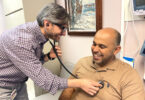Sunnybrook recently asked our social media followers to send us their questions about COVID-19 and staying safe during the pandemic. Natasha Salt, our Director of Infection Prevention & Control, shares her answers below.
For more information about COVID-19 and Sunnybrook, visit sunnybrook.ca/COVID19
How can I protect myself if I work in close proximity to others?
With more people returning to work, there are a few strategies you can use to keep yourself and your colleagues healthy:
- Healthy workplace policy – It’s important that all workplaces establish a healthy workplace policy, which means only healthy people should be in the workplace. If you’re sick, or if you develop any new signs or symptoms of infection, you should be excluded from work and stay at home.
- Clean your hands – This one is so important. Our hands can serve as the portal of entry into our mouth, nose and eyes, so if they’re contaminated, that’s how a virus can be introduced into our bodies. Washing your hands with soap and water or using an alcohol-based hand sanitizer are both effective methods in reducing the spread of viruses and germs.
- Wear a mask – Health Canada is recommending that you wear a non-medical grade mask or a fabric mask outside of your home. Doing so helps to contain secretions, so that if you’re coughing and sneezing, those droplets are contained within your mask rather than being dispersed into the air.
- Disinfect shared surfaces – Frequently touched surfaces, like a shared computer or doorknobs, can become contaminated, so should be disinfected often.
Is there a right way to wear, put on and take off a non-medical grade or fabric mask?
The first thing you should always do before putting on a mask is to clean your hands for at least 15 seconds. In fact, you should clean your hands any time you touch your face.
With clean hands, take the mask and secure it around your ears (if it’s an ear-loop style). It should fit nice and snug around your face. You want to fully cover your nose and all of your mouth, so the mask should come down under your chin as well. A mask is meant to contain your coughs and secretions, so if you cough or sneeze and the mask is only covering your mouth, it’s not doing its job.
The process is similar for taking off your mask. Before removing it, clean your hands first. Grab the mask by the ear loops and pull it away from your face, and put it down on a clean surface or napkin. Clean your hands again afterwards.
It’s important to remember that the front of the mask could be contaminated, so you should regularly clean your fabric mask. You can do this by putting it in the washing machine or washing it with soap and water then soaking it in a bleach-water solution.
I can’t find wipes or disinfectant anywhere. What do I do to clean my house?
There is high global demand for commercially prepared disinfectants, so they can be hard to find these days. The good news that you can prepare your own household disinfectant. Bleach (at 5.25% concentration) can be combined with water to effectively disinfect your home. When you combine 5 millilitres of bleach with 2.5 litres of water, and it’s prepared fresh daily, this solution can be used to disinfect surfaces.
However, you want to make sure surfaces are clean before you disinfect them. Use a soap and water solution to clean surfaces first, removing any dirt, grime or oils that have accumulated. You can then apply the bleach with water solution, either by spraying it or by using a wet rag immersed in the pail with the solution.
The “wet contact time” (meaning the length of time that a disinfected surface remains wet) of the bleach with water solution should be at least 10 minutes, which is how long it takes to kill off a lot of viruses and bacteria we want to target.
Stores are now open. Is it still recommended that I only leave my house for essential outings?
It’s still best practice to try and restrict your activity unless it’s outdoors with good physical distancing, and to only go to stores for essential trips. It’s been great to see many stores take ownership over making sure their environment is safe, like implementing physical distancing requirements and making hand sanitizer readily available.
If you do have to go to a store, wear a non-medical grade mask if you’re able to and always remember to travel with your own hand sanitizer, as you never know whether it will be available when you’re out and about.
What are you doing to keep your own family safe and healthy?
I get asked this question a lot, and I tell everyone the same thing: I’ve tried to maintain as much of a normal, healthy balance of life that COVID-19 allows. We’re a family that loves to get out and do excursions, and we haven’t stopped doing that. What we have done is make adjustments, like avoiding times that are really busy and making sure that we’re physically distancing ourselves from others.
It’s been interesting to watch my children picking up on the new rules of “COVID life,” like using their elbows to touch buttons, or their hips to open a door. They also know that as soon as they walk in the door, the first thing they need to do is clean their hands.
Should I wear gloves when I leave the house?
I have never been a fan of wearing gloves when it’s not necessary. Even in health care, workers are generally not required to wear gloves unless they’re coming in contact with blood or body fluids. Gloves often give people the false sense of security that they’re protecting themselves. It’s important to recognize that the only way we can become infected is when the virus enters our mouth, nose or eyes, and this can still happen when you’re wearing gloves and touch your face. Hands are just a vehicle that transports the virus to our mouth, nose or eyes, so frequent hand hygiene is very important.
With that being said, if you do elect to wear gloves, sanitize your hands before putting them on. Keep your hands away from your face when you’re wearing the gloves, as they will still become contaminated when you touch surfaces like doorknobs, grocery carts, etc. Gloves cannot be reused – you can’t safely take them off and put them back on because you’ll be touching the contaminated parts of the gloves, potentially infecting yourself if you then touch your face. Once you’ve removed your gloves, sanitize your hands again. Never sanitize your gloves as hand sanitizer is not intended for that surface, so it won’t kill the virus.
Is it safe to allow our children to play with friends, either indoors or outdoors?
Ideally, we should still try to keep our circle of contact very small. The virus is still circulating in the community, and we don’t know what people’s exposure has been.
Having said that, I do have two young children who are anxious to see their friends. We’ve been trying to do our best by connecting with others using Zoom and FaceTime. At the same time, people are going out more and more with the warm weather. If you do choose to meet up with other people, try to do it outside, and choose an activity where a physical distance of 6 feet can be maintained. Make sure no one has symptoms and perform hand hygiene often.
How long will it take to develop a vaccine, and how long will it last?
There are a lot of people working hard to make a vaccine happen. Realistically, we’re at least 12-18 months away from any sort of vaccine being widely available. We also won’t know how long that vaccine will be able to protect us from re-infection of the virus.
When we look at other types of viruses like the flu, the circulating strains change from season to season, so a vaccine is developed each year based on which strain is predicted to be circulating. That’s why it’s so important to get the flu vaccine every year. On the other hand, there are other vaccines that offer much longer protection. So, we’ll have to wait and learn more about this virus before we’ll know how long protection from a potential vaccine might last.
What about herd immunity – what does it actually mean, and can we achieve it?
Herd immunity happens in two ways: one is when you are actively infected with a virus, and the other is when you are vaccinated against a virus.
It’s different for different viruses, but generally speaking, 70%-90% of a population needs to become immune in order to create herd immunity. For example, when you take a room of 100 people, and 70 to 90 people are immune to a particular disease, it’s less likely that transmission of that disease will happen.
With COVID-19, in countries that haven’t put restrictions in place, there has been a lot of spread. As a result, a lot of people have required health care all at once, which puts a lot of strain on the health care system.
In Canada, we’ve taken a more restrictive approach, which has actually slowed down the spread of the virus so that we can manage it in our health care system over a longer period of time. This approach also buys us time in terms of waiting for a vaccine.
Will it signify the end of the pandemic when we achieve herd immunity? We aren’t sure about that yet. Only time will tell.








